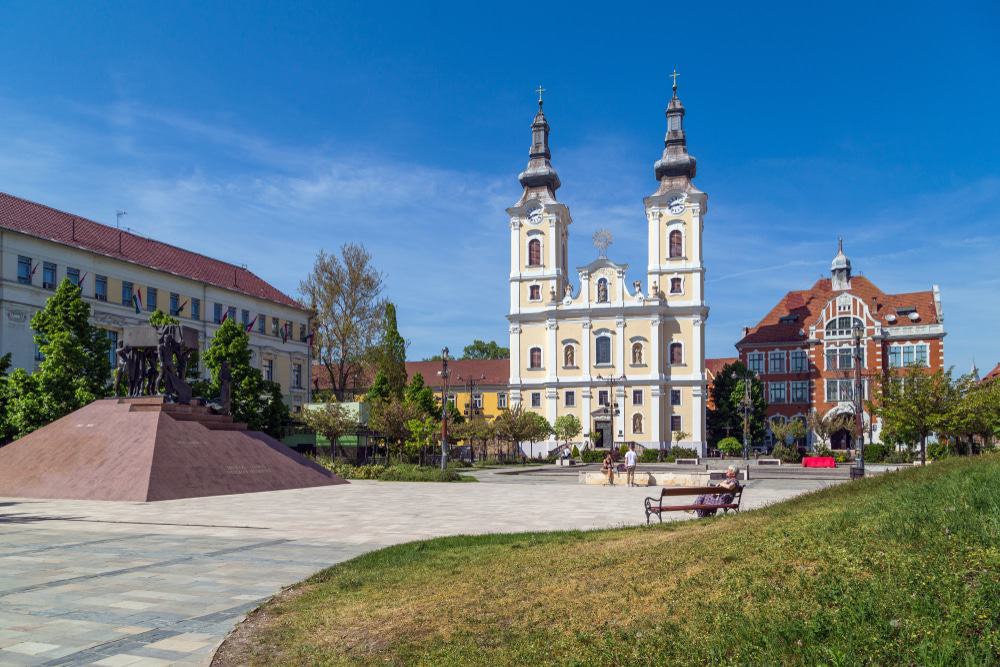Summary
- Castle of Diós győr
- Lillafüred
- Terraced Gardens in Lillafüred
- Lillafüredi Vízesés (Lillafüred Waterfall)
- Hámori Lake
- Ottó Herman Múzeum
- Pannon Sea Museum
- Greek Orthodox Church
- Gothic Protestant Church of Avas
- Miskolc Cave Bath
- Wooden Church
- Lillafüred Forest Train
- Miskolc Zoo
- Miskolc-Avas TV Tower
- Kocsonyafesztivál (Meat-Jelly Festival)
An industrial city located in northeastern Hungary, Miskolc is surrounded by extensive beech-covered mountains at the Bük k National Park.
In medieval times, Diós győr Castle, which is now part of Miskolc, served as a refuge for the Kings and Queens of Hungary. The recently restored monument hosts medieval fairs and historical reenactments during the summer months.
To the west lies Lillafüred, beautifully nestled among tall hills in the national park, featuring an opulent lakeside hotel dating back to the 1920s atop terraced gardens.
In the center of the city, visitors will find art museums as well as Orthodox and Gothic Medieval churches. The Miskolctapolca spa resort, located in the suburbs, boasts thermal pools situated within a natural limestone cave.
Let us examine the top attractions in Miskolc:
1. Castle of Diós győr

Situated eight kilometers west of Miskolc’s center, the Castle of Diós győr perches on a ridge at the foothills of the Bük k Mountains.
This fortress was modified by Louis I of Hungary in the mid-14th century, which marked the castle’s most prosperous era.
For 150 years leading up to 1526, it was bequeathed to a succession of six different queens, thus earning the moniker “Castle of Queens.”
The castle is designed on a square layout featuring a towering structure at each corner.
The majority of the complex has been restored and beautified up to its second level, except for the southwestern wing that has remained in ruins since struck by lightning in the 1800s.
The best time to visit is in May and August during the “Castle Games,” a festival featuring Medieval tournaments, marketplaces, and reenactments of significant events from Hungary’s history.
2. Lillafüred

Located a bit further west, Lillafüred is an attractive resort that emerged in the early 20th century amidst the mountainous setting of Bük k National Park.
Overlooking the finger-like Hámori Lake is the Palace Hotel, which was designed in an exquisite neo-Renaissance architectural style in the late 1920s by architect Kálmán Lux.
Gracefully cascading down the slopes are well-designed terraced gardens, which will be detailed further in the subsequent section.
Nearby, visitors can explore natural limestone caves, extensive oak and beech forests, a narrow-gauge railway, and a small museum dedicated to the polymath Ottó Herman.
3. Terraced Gardens in Lillafüred

The cascading gardens beneath the hotel are laid out across themed terraces positioned between the Szinva and Garadna streams.
This area also features Hungary’s tallest waterfall, which reaches 20 meters in height and is ingeniously manmade.
Each terrace en route to the Palace Hotel bears distinctive names such as the “Terrace of Youth and Meetings,” which includes a playground and outdoor recreational space, as well as the Terrace of Flowers, adorned with vibrant flowerbeds throughout the summer months.
Additionally, the Terrace of Sculpture serves as an open-air exhibition space showcasing sculptures and public art installations, while at the base of the waterfall lies the “Anna Lookout,” positioned above the Anna Cave.
4. Lillafüredi Vízesés (Lillafüred Waterfall)

Upon viewing the picturesque waterfall adjacent to the terrace, it is surprising to learn that it is not naturally occurring.
This waterfall was created in the late 1920s when the Szinva River was rerouted to facilitate the construction of the Palace Hotel.
Regardless, standing at 20 meters tall, it is the highest waterfall in Hungary and evolves with the seasons.
In spring, it cascades vigorously, whereas, by August, it may trickle lightly, and in mid-winter, it may entirely freeze.
Adjacent to the falls, a bronze statue of the esteemed 20th-century poet, József Attila, can be found, whose works have gained global acclaim.
This terrace commemorates his poem, “Ode,” which he penned after visiting Lillafüred.
5. Hámori Lake

Like much of Lillafüred, the lake at the resort exists due to human intervention, formed when the Szinva and Garadna streams were dammed in the early 19th century in order to provide a constant water source for an iron furnace.
The lake extends 1.5 kilometers and winds through the towering wooded valley sides.
Along the eastern shore near the resort, a scenic promenade invites visitors to stroll, and during summer, bicycles can be rented or rowboats and paddleboats can be hired for a short venture.
Hámori Lake typically freezes over in winter, providing an opportunity for ice skating during January and February.
6. Ottó Herman Múzeum

This comprehensive museum, named in honour of the 19th-century polymath Ottó Herman, is the largest in the city, comprising collections gathered across Borsod-Abaúj-Zemplén County.
The main edifice is the grand hall located on Görgey Utca, showcasing galleries dedicated to Hungarian painting from the Baroque period to Art Nouveau, organized chronologically.
Visitors start with 17th and 18th-century masters like Jakab Bogdány and Ádám Mányoki, progressing to Romantics such as Viktor Madarász and Mihály Munkácsy.
Eventually, they encounter the onset of Modernism in Hungary through works by artists like József Rippl-Rónai and János Nagy Balogh, who were active at the turn of the 20th century.
7. Pannon Sea Museum

Part of the same institution, the Pannon Sea Museum underwent a renovation in 2013, featuring two new exhibitions that transport visitors back to the era of the prehistoric Pannonian Sea.
The majority of present-day Hungary was submerged under this body of water during the Miocene and Pliocene Epochs, up to two million years ago.
With an engaging yet educational approach, the museum narrates the tale of fossilized seven-million-year-old cypress trees located thirty minutes south of Miskolc in Bükkábrány.
The displays also feature fossils of ancient flora and fauna, including the remains of a rudapithecus, a substantial ape considered a possible ancestor of humans who inhabited the region approximately ten million years ago.
8. Greek Orthodox Church

Constructed at the beginning of the 19th century in the late-Baroque Zopf style, Miskolc’s Greek Orthodox Church is home to the largest Iconostasis in Central Europe.
This remarkable piece, embellished with marble and gold Solomonic columns, rises to a height of 16 meters and encompasses 88 paintings depicting the Life of Jesus.
Most of these paintings were created by the Austrian artist Anton Kuchelmeister, while the frame was crafted at a workshop in Eger.
The churchyard features a cemetery with gravestones dating back three centuries. From here, visitors can access the Orthodox Museum.
The first exhibit replicates the small chapels where Hungary’s Orthodox communities worshipped prior to the construction of larger churches.
The second room showcases vestments such as a sticharion, while the third room displays goldsmithery and an assortment of icons.
9. Gothic Protestant Church of Avas

Miskolc’s oldest monument is a Reformation church nestled on the lower slopes of Avas Hill in the city’s center.
The church was initially established in the 13th century, with the original Romanesque structure being expanded with a late-Gothic German-style hall church in the 15th century.
Subsequently, during the Ottoman occupation in 1544, the church lost its roof. Due to its Protestant affiliation, the Catholic proprietor of the Diós győr estate declined to provide the necessary timber for repairs, leaving the structure exposed for two decades before it was ultimately restored.
The belfry features a carillon playing a rendition of the Westminster Quarters every 15 minutes since 1941. Adjacent to the church is a 10-hectare cemetery, home to gravestones from the 17th and 18th centuries, which serve as the final resting place for numerous prominent citizens, including Bertalan Szemere, the prime minister during the Hungarian Revolution of 1848.
10. Miskolc Cave Bath

Supplied by thermal waters that filter through the karst stone of the Bük k Mountains, this bathing complex is situated within a natural cave and forms part of the larger Miskolctapolca spa resort.
Visitors can enjoy seven indoor pools, including a hydro-massage pool, surrounded by the cave’s natural limestone walls, with water temperatures ranging from 29 to 35°C. Additionally, during the summer season, outdoor pools are available, including three designated for children’s enjoyment.
For complete relaxation, the Sauna Park features a steam cabin, various Finnish saunas of differing sizes, three “infrasaunas,” and an immersion pool with a refreshing temperature of 16-18°C for cooling off.
11. Wooden Church

A cherished site in Miskolc, this church appears older than it is; it was completed in 1999. Its predecessor, built in 1938, succumbed to an arson attack in 1997, replacing an earlier wooden church that had existed since the 18th century.
A notable anecdote associated with the church is that a 19th-century Miskolc resident, István Bató, bequeathed a significant sum, insisting it be rebuilt should it ever catch fire.
Like its predecessor, the current structure features intricately carved spruce decorations crafted by artisans from Transylvania, while its body is composed of larch and pine.
12. Lillafüred Forest Train

From May to September, this charming narrow-gauge railway attracts tourists; however, it was originally constructed in the 1910s for industrial purposes.
Connecting Miskolc with Garadna, the train was initially intended for freight transport, specifically timber from the Bük k Mountains.
Within three years of its establishment, a passenger service was introduced, providing a scenic method of reaching Lillafüred from Miskolc.
The line winds through gorges and abrupt elevations, offering passengers beautiful views of the surrounding mountains.
The diesel-powered engines produce considerable noise, while the route may be bumpy, which adds to the enjoyment of the journey.
Notably, the ticket inspector moves along the outside of the carriages, providing a unique sight.
13. Miskolc Zoo

Initially established by King Louis I in the 14th century, the zoo at this site near Diós győr holds the distinction of being the oldest in Hungary.
Visitors may choose to explore the zoo before venturing into the Bük k Mountains, as it houses numerous species native to the region, including brown bears, wildcats, buffaloes, and various deer and goats.
Additionally, the zoo features exotic animals from regions including Asia, Australia, North America, South America, and Africa, such as kangaroos, kookaburras, raccoons, peccaries, macaques, camels, a tiger, patas monkeys, and a Persian leopard.
The facility also includes an eco-park where visitors can ascend a nine-meter platform within the forest canopy and cross a suspension bridge situated 32 meters above the forest floor.
14. Miskolc-Avas TV Tower

Dominating Avas Hill to the south of Miskolc’s city center is an arresting example of Soviet-era architecture.
This space-age structure was erected in 1966, designed by Hungarian architects Miklós Höfer and György Vörös.
It replaced an observation tower that had been built in 1934 by Bálint Szeghalmy, who was also responsible for Miskolc’s Wooden Church.
The previous structure was named in honour of Francis II Rákóczi, a national hero who spearheaded the uprising against the Habsburg Empire in the early 18th century.
This earlier tower was partially destroyed by fire in 1934 and completely annihilated in 1956, allegedly by a Russian tank during the 1956 Revolution.
While the current tower has seen better days, it is worth the effort to climb Avas Hill for a panoramic view of the city.
15. Kocsonyafesztivál (Meat-Jelly Festival)

Every February or March, Miskolc hosts a folk festival celebrating the end of winter.
This event spans a weekend in the city center at Hősök Tere (Heroes’ Square) and Városháza Tér (Town Hall Square). As indicated by the name, the Meat-Jelly Festival centers around aspic, a valued local delicacy.
The festival features aspic sculpture competitions, tasting stands, cooking contests, culinary demonstrations, live music, and various activities for children.
The festival’s emblem is a frog.
This symbol derives from an old legend of a frog that inadvertently leapt into a bowl of aspic and appeared surprised when it was served alive and blinking within the jelly.
This amusing tale has given rise to a popular Hungarian idiom expressing surprise: “Blinking like a frog in Miskolc meat jelly.”





